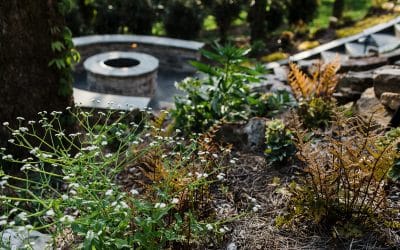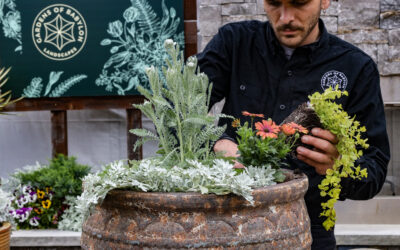Gardening isn’t just for the summer months. The seasoned gardener knows there are things they can be doing each month of the year to make gardening more fruitful and easier each year.
January & February

Now is a great time to start planning your gardens for the spring and summer! If you’re completely new to gardening, planning early can be one of the best things you can do for yourself. It helps dispel potential stressors when spring rolls around, and it gives you time to educate yourself on how to start, care for and maintain your garden.
Winter is also optimal for redefining garden bed edges, whether that means sprucing up existing ones with new materials or plotting out new areas. January and February are also good months to freshen up the mulch covering your garden beds. You can dispose of the wood shavings or bark, rake off any debris, and then replace it with a fresh layer of compost or mulch. This will keep nourishing your beds until you’re ready to plant in the spring. For more details on how to boost spring results by preparing in the winter, check out this blog post.
When it comes to trees and shrubs, you can do some light pruning during the cold months while plants are dormant. Be sure to not prune too much, as you don’t want to invite in any pests or diseases.
Depending on what you plan to grow this spring, February can be ideal for starting seeds indoors. Generally the back of your seeds packet will tell you the best times for starting seeds indoors and when to move the seedling outdoors and into your garden.
March

While you can start some seeds indoors in February, most seeds are best started in March! It’s often still too cold outside for most seeds to survive, as the final hard frost of the year is after spring has officially started. However, there are some cold-hardy plants whose seeds you can start outside in mid-to-late March, including arugula, beets, broccoli, fava beans, kale and more.

Depending on where you live in the mid-state and how spring is faring this year, there are even some cool-weather plants you can welcome to your garden beds. Think hardy veggies, like lettuce, radishes and carrots. As for decorative plants, March can be prime time for planting annuals that can handle cold snaps, like pansies and snapdragons.
April

After the final hard frost of the year, which generally occurs the first week of April, it’s time to start planting! Whether you’re starting your own seeds indoors (be sure to check your seed package for best times to start based on where you live) or are transplanting young fruit and vegetable plants from a garden center, April is probably the month to start. If you’re starting seeds outdoors, late April is often optimal as it’s finally warm enough. Plus, if timed correctly, you can plant new seeds and transplants in intervals – much like the Amish do – to ensure you’re getting fresh produce all summer long.
April in middle TN can be unpredictable, so be sure to check the hardiness levels of your plants. You might need to cover your garden at night should temperatures drop too low.
Now is the time to plant your summer bulbs, like dahlias, as the soil is finally warming up. You can also start pruning flowering shrubs and climbing roses after they’ve bloomed to help reshape them and trim any straggling branches.
May & June

You can continue planting new seeds and seedlings for most summer plants (okra, squash, zucchini, etc.) throughout the summer. If you haven’t started yet, don’t fret! You can keep planting through May, June and most of July.
As the summer ramps up, keep an eye on the moisture levels in your garden. Heat in middle TN can be deceptive with the humidity. Check your soil daily to make sure you aren’t under- or over-watering your garden.
May is optimal for replacing your spring annuals with warm-weather annuals as middle TN starts heating up. If you have tropical bulbs you’ve been waiting to sow, May is also the month to start planting those. These heat-tolerant plants will thrive in June and July.
July

Your summer garden is likely producing most of its yield this month and into August. So, the best things you can do to care for it would be watering it regularly, harvesting produce as it’s ready, pulling weeds as they pop up, removing dead plants as they yield their final fruit, and picking up any debris that might get in the way of your plants. These same rules go for your flowering plants – remove any faded blooms, do some light trimming as necessary, and clean up debris from your yard and plant beds.
Toward the end of July and into August as you begin to clear out your garden of summer plants, you can also begin planting seedlings and transplants for fall produce, like Brussels sprouts, carrots and other root vegetables.
August

If you’re not quite ready to say goodbye to your produce for the year, mid-to-late summer is a great time to plant seeds for produce that is cold-weather hardy, especially many root vegetables. These crops include broccoli, cabbages, carrots, garlic, radishes, spinach, turnips and more. For more tips on how to transplant and care for these, check out our post on preparing your garden for fall.
Continue basic maintenance for your vegetable gardens and landscaping alike, as you remove dead plants and flowers and care for growing ones.
September & October

It’s time to gather up your final harvests! Whether or not you planted a fall garden, once your plants have finished producing fruits and veggies, it’s time to pull up those that are dead or dying. Now is also a great time to trim foliage and clean up other debris in your garden beds. If you’re anything like me, you might also have gotten tired of pulling weeds in the summer heat. So, now that weeds are drying up and the temperature is cooling down, it is the perfect time to pull those pesky garden invaders.
For more soil maintenance, you can also top off your garden beds with compost, organic fertilizer, mulch, or shredded leaves. If you don’t want your garden to lay bare or be taken over by grass until next summer, you can take a little tip from my dad who’s farmed and gardened his entire life. Till up the soil and plant clover or another cover crop. It will bloom into lovely hues of green, crimson and purple and also attract pollinators. Other cover crops include alfalfa, buckwheat, annual rye and mustard greens. Then, when you’re ready to plant your garden next summer, you can use a garden tiller to pull the cover crop and rotate it back into the soil for nourishment.
If you have perennials or annuals, September and October are great months to be pruning and deadheading these plants. You can gather up the final blooms to make bouquets for yourself or as gifts for friends and family as a final homage to summer.
While harvesting might be over, fall in Tennessee is the best season for plantings. Don’t believe me? Read these five reasons why fall is the best season for planting. Due to middle TN having a temperate climate, plants in this area don’t die in the winter – they go dormant! This, paired with the cooler temperatures and higher moisture of fall, means that your new plants can establish a healthy environment before going dormant for the winter.
November

All the leaves have fallen by now, so this is a good time to rake up and mulch leaves. After mulching leaves, you can spread them across your garden beds to help snuff out weeds while also nourishing the soil for next spring.
Depending on what you planted in your fall garden, you might still be harvesting in November. Collect the final harvests and clean up what you can. If you didn’t clean up all the weeds and debris last month, now is a great time to do so before the holidays are in full swing and the temperatures drop. You can also pull up any other diseased or dead plants in your yard before the ground gets too hard.
Looking to add color to your yard next spring? November can be just right for planting perennial bulbs, like narcissus, to ensure they pop up in the spring.
December

If you still haven’t cleaned up your garden beds, this month is the month to do it. Hard frosts have likely killed off anything that was left in your fruit and vegetable gardens, so be sure to clean out dead plants, weeds and debris – that way your garden will be ready to go in the new year. Happy gardening!
Have more questions, or need help planning out your garden and maintenance for the year? Reach out to our team, or visit our garden center in Nashville!







0 Comments